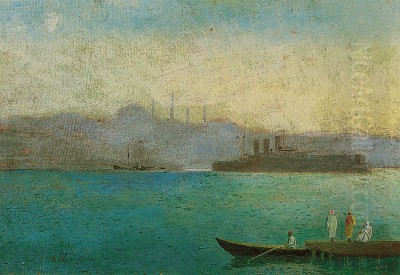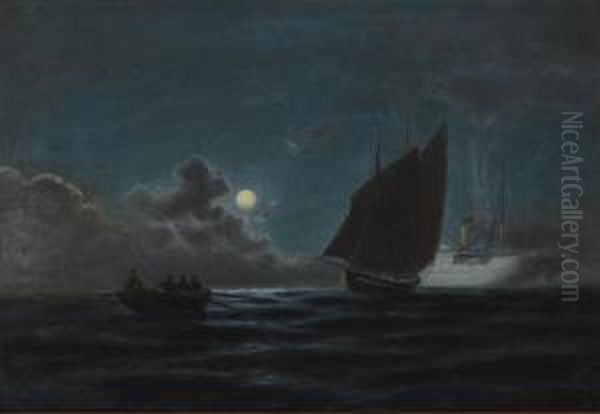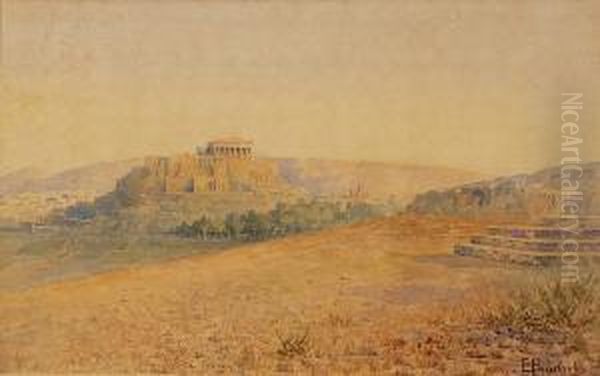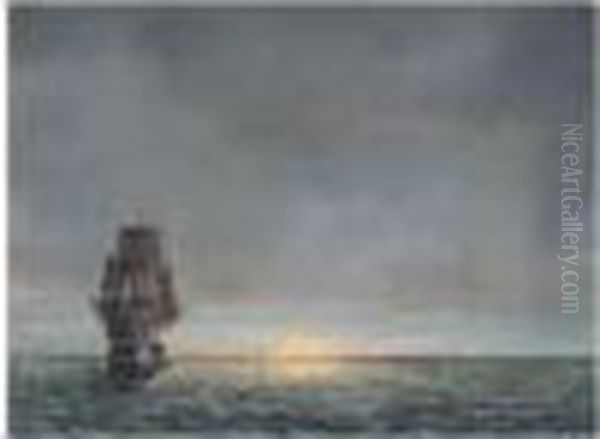
Emilios Prosalentis, a distinguished figure in the annals of Greek art, stands as a testament to a rich artistic lineage and a profound personal connection with the maritime world. Born in 1859 on the picturesque island of Corfu and passing away in Athens in 1926, Prosalentis dedicated his life to capturing the multifaceted beauty of the sea. His canvases, often bathed in the ethereal glow of moonlight or the vibrant hues of a Mediterranean sunset, not only showcase his technical prowess but also reveal a deep, almost spiritual understanding of the marine environment. As a painter, particularly renowned for his seascapes, his work forms an important chapter in the narrative of modern Greek art, bridging the academic traditions of the 19th century with a more personal, observational approach.
A Legacy Forged in Art: Early Life and Family Influence
The artistic journey of Emilios Prosalentis was, in many ways, preordained by his remarkable family heritage. He was born into a dynasty of artists who had already left an indelible mark on the cultural landscape of Greece. His grandfather, Pavlos Prosalentis the Elder (1784-1837), was a pioneering sculptor and painter, considered one of the founders of the Ionian School of art, which sought to blend Western European artistic currents with local traditions. This artistic environment was further enriched by Emilios's father, Spyridon Prosalentis (1830-1895), himself a respected painter known for his portraiture and historical scenes. Spyridon served as a direct mentor to his son, imparting foundational skills and fostering an appreciation for the classical tenets of art.
The Prosalentis household was a crucible of creativity, with Emilios's siblings also pursuing artistic careers. His brother, Pavlos Prosalentis the Younger, continued the family's sculptural tradition, while his sisters, Eleni and Olga Prosalentis, also became recognized artists. This familial immersion in the arts undoubtedly provided Emilios with an unparalleled early education, exposing him to diverse techniques, ongoing artistic discourse, and a supportive network that encouraged his burgeoning talent. Growing up in Corfu, an island with a vibrant cultural history and stunning natural beauty, further shaped his aesthetic sensibilities, with the omnipresent sea becoming a recurring motif in his later work.
Formal Training and Parisian Horizons

To formalize his artistic education, Emilios Prosalentis enrolled at the Athens School of Fine Arts, the premier institution for artistic training in Greece at the time. Here, he would have been exposed to the prevailing academic style, which emphasized meticulous draughtsmanship, balanced composition, and often, themes drawn from Greek history and mythology. Instructors at the School, such as Nikiforos Lytras (1832-1904), a leading figure of the Greek "Munich School" who had returned to teach in Athens, would have instilled a rigorous approach to painting. Lytras, known for his genre scenes and portraits, represented the academic tradition that many Greek artists of the era embraced.
Seeking to broaden his artistic horizons and engage with the latest European trends, Prosalentis, like many aspiring artists of his generation, traveled to Paris. The French capital was then the undisputed center of the art world, a vibrant hub of innovation and tradition. While in Paris, he is noted to have pursued further studies, and some sources suggest he also delved into engineering. This dual interest, if accurate, might speak to a methodical aspect of his personality, one that appreciated precision and structure – qualities that can subtly inform an artist's approach to composition and perspective. More significantly, his time in Paris exposed him directly to the influences of French landscape painting, particularly the Barbizon School and the burgeoning Impressionist movement, which emphasized plein air painting and the subjective experience of light and atmosphere. Artists like Jean-Baptiste-Camille Corot (1796-1875) and Charles-François Daubigny (1817-1878) of the Barbizon School, with their poetic naturalism, and Impressionists like Claude Monet (1840-1926) and Alfred Sisley (1839-1899), with their revolutionary treatment of light and color, were transforming the landscape genre.
The Allure of the Sea: Style and Thematic Focus
Emilios Prosalentis is primarily celebrated as a marine painter, an artist who found endless inspiration in the ever-changing moods of the sea. His style, while rooted in academic realism, shows a distinct sensitivity to the atmospheric effects championed by the French landscape painters he encountered. He developed a remarkable ability to capture the subtle nuances of light on water, whether it was the shimmering reflection of the moon on a calm sea, the dramatic play of light and shadow during a storm, or the soft glow of dawn or dusk over the waves.

His seascapes are characterized by their verisimilitude, a faithful representation of maritime scenes, yet they are imbued with a romantic sensibility. He was particularly adept at depicting ships, from traditional sailing vessels to modern battleships, rendering them with an accuracy that perhaps benefited from his engineering studies or his later naval career. Unlike the more abstract or purely light-focused studies of some Impressionists, Prosalentis often maintained a strong narrative or descriptive element in his work, grounding his atmospheric explorations in tangible reality. His contemporary, Konstantinos Volanakis (1837-1907), another preeminent Greek seascape painter, shared this passion for maritime subjects, though Volanakis often focused on historical naval battles and bustling port scenes with a slightly different, perhaps more overtly dramatic, flair. Both artists, however, contributed significantly to establishing marine painting as a major genre in Greek art.
A unique aspect of Prosalentis's career that profoundly influenced his art was his service as a naval engineer officer. This profession afforded him extensive opportunities to observe the sea in all its conditions and from various perspectives, far beyond what a land-based artist might experience. He spent considerable time on board ships, intimately acquainted with the rhythms of naval life and the vastness of the open ocean. This firsthand experience lent an authenticity and depth to his marine paintings, allowing him to depict not just the appearance of the sea, but also its inherent power and character.
Masterworks of Maritime Majesty
Emilios Prosalentis's oeuvre includes several key works that exemplify his skill and artistic vision. Among his most recognized paintings is "Sailboat in the Open Sea." This piece, housed in the Maritime Museum of Crete (often referred to as Mis Art Museum in some contexts), likely showcases his characteristic ability to render the interplay of light on water and the elegant form of a sailing vessel navigating the expanse. Such works often evoke a sense of solitude, freedom, or the timeless human relationship with the sea.
Another significant work is "The Battleship 'Averoff' at Constantinople," painted around 1922. The Georgios Averoff was a celebrated armored cruiser of the Hellenic Navy, a symbol of Greek naval power in the early 20th century. Depicting this iconic warship, particularly in the historically resonant setting of Constantinople (Istanbul), would have carried considerable patriotic and historical weight. This painting demonstrates Prosalentis's ability to combine meticulous detail in rendering naval architecture with a broader sense of historical moment. His paintings of naval vessels often served as important historical documents as well as artistic achievements.

His painting titled "Moonlight" highlights his particular mastery in capturing nocturnal seascapes. The challenge of depicting the subtle gradations of light and shadow under moonlight, the reflections on the water, and the overall atmosphere of tranquility or mystery, was one that Prosalentis met with great success. These moonlit scenes are among his most poetic and sought-after works, showcasing a delicate balance between realism and romanticism. Similarly, "Sailing at dusk" would explore the transient beauty of twilight, with its warm, fading light and long shadows, a time of day favored by many landscape artists for its evocative qualities.
The work "The Acropolis," dated 1897 and held by the National Gallery of Greece, indicates that Prosalentis also engaged with iconic terrestrial landscapes, though he is less known for these. Depicting the Acropolis, the ultimate symbol of Greek heritage, would have been a common subject for artists of his era, and Prosalentis's interpretation would offer insight into his handling of architectural forms and historical atmosphere beyond the maritime context.
Urban Vistas and Broader Artistic Endeavors
While the sea remained his dominant muse, Emilios Prosalentis also turned his skilled hand to urban landscapes, particularly during his time in Constantinople. He created numerous cityscapes featuring the majestic Hagia Sophia, capturing the historic edifice under varying light conditions. These works demonstrate his keen observational skills extending to architectural subjects and the bustling life of a major city, always with a sensitivity to the prevailing atmosphere and the play of light that characterized his seascapes.
His artistic output was not limited to grand canvases; he was also proficient in watercolor, a medium favored by many artists of the Ionian School for its immediacy and luminosity. In Corfu, he, along with artists like Angelos Giallinas (1857-1939) and Vikentios Bokatsiatis (Boccatzambis, 1856-1933), contributed to a vibrant watercolor tradition. Giallinas, in particular, became highly renowned for his luminous watercolor landscapes of Corfu and other Greek scenes, sharing with Prosalentis a deep appreciation for the Mediterranean light.
The influence of French art on Prosalentis is evident, but he remained a distinctly Greek artist, interpreting international trends through the lens of his own cultural heritage and personal experiences. His work can be seen in dialogue with other Greek painters of his time. Beyond Volanakis and Giallinas, artists like Ioannis Altamouras (1852-1878), another gifted marine painter whose promising career was cut tragically short, also explored the allure of the sea. The broader Greek art scene included figures from the "Munich School" like Georgios Jakobides (1853-1932), known for his tender depictions of childhood, and Nikolaos Gyzis (1842-1901), a towering figure whose work spanned portraiture, genre scenes, and allegorical subjects. While their thematic concerns often differed, they all contributed to the rich tapestry of 19th and early 20th-century Greek art.
Prosalentis and His Contemporaries: A Greek Pantheon
Emilios Prosalentis operated within a dynamic Greek art world. The Ionian Islands, including his native Corfu, had a distinct artistic tradition, often more directly influenced by Italian and Western European art due to historical connections. Artists like Charalambos Pachis (1844-1891), also from Corfu and a teacher to Giallinas, were part of this milieu, focusing on portraiture, genre scenes, and landscapes that reflected the unique character of the islands.
In mainland Greece, the "Munich School" held sway for much of the 19th century. This group of Greek artists who studied at the Royal Academy of Fine Arts in Munich, Germany, brought back a style characterized by academic realism, often with an ethnographic interest in depicting Greek life and customs. Nikiforos Lytras, Konstantinos Volanakis, Nikolaos Gyzis, and Georgios Jakobides were its leading exponents. While Prosalentis shared their commitment to representational accuracy, his Parisian exposure and focus on atmospheric effects in his seascapes set him somewhat apart, aligning him more with painters who embraced landscape for its own sake, rather than primarily as a backdrop for narrative or genre scenes.
As the 20th century dawned, new artistic currents began to emerge in Greece, with artists like Konstantinos Parthenis (1878-1967) and Spyros Papaloukas (1892-1957) moving towards Modernism, incorporating elements of Post-Impressionism, Symbolism, and Fauvism. While Prosalentis remained largely within the realm of late 19th-century realism and Impressionist-influenced landscape, his dedication to capturing the ephemeral qualities of light and sea can be seen as a bridge towards a more subjective and expressive approach to painting. His work, therefore, occupies an important position, representing the culmination of certain 19th-century traditions while also hinting at the evolving artistic landscape. Internationally, one might also consider his work in the broader context of marine painters like the British artist J.M.W. Turner (1775-1851), whose dramatic and atmospheric seascapes revolutionized the genre, or French painters like Eugène Boudin (1824-1898), a mentor to Monet, celebrated for his depictions of coastal scenes and luminous skies.
Enduring Legacy and Esteemed Collections
The artistic contributions of Emilios Prosalentis have been recognized through the inclusion of his works in numerous prestigious public and private collections. The National Gallery of Greece in Athens, the foremost repository of modern Greek art, holds examples of his work, including "The Acropolis." The Athens Municipal Gallery and the War Museum in Athens also feature his paintings, the latter likely showcasing his depictions of naval subjects. His connection to the Averoff family and the Greek Navy is further underscored by the presence of his art in the Averoff Gallery in Nicosia, Cyprus, and the Leventis Gallery.
His maritime specialization is particularly celebrated in institutions dedicated to seafaring history, such as the Maritime Museum of Crete in Chania, which proudly displays "Sailboat in the Open Sea." The continued appearance of his paintings in art auctions, such as "Paysage marin" which was sold to benefit the Greek Cancer Society, attests to his enduring appeal among collectors and the public. These sales not only reflect the market value of his work but also highlight how his art continues to contribute to cultural and philanthropic endeavors.
Emilios Prosalentis's legacy is that of a dedicated and skilled painter who masterfully conveyed the beauty and power of the Greek seas. He inherited a rich artistic tradition from his family, honed his skills through formal education in Athens and Paris, and brought a unique observational depth to his work, enriched by his experiences as a naval officer. His paintings serve as luminous windows onto the maritime world of his time, capturing not just its physical appearance but also its evocative atmosphere. He remains a significant figure in Greek art history, admired for his technical proficiency, his sensitive handling of light, and his profound connection to the sea that defined so much of his life and art. His work continues to inspire appreciation for the timeless allure of the marine landscape and the enduring power of representational art.